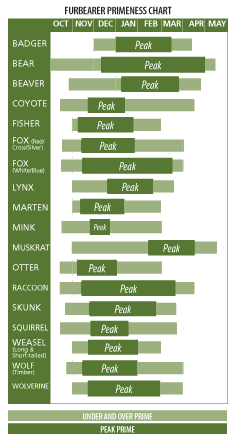I have had a lifelong interest in trapping muskrats since the early 1950's, and have responded to threads about them from experience and research. However, I am not an expert nor a fur buyer/dealer, but I am intimately familiar with them.
Though I have never trapped in Manitoba, I am briefly familiar with your trapping regulations and zones up there, and I assume this is the primeness chart that came from your Province that you are referring to:

This is a comparable one from Minnesota:

As you can tell, each of these are best estimates, showing both the "peak" and the range over the duration of primeness, developed from long term averages obtained through research studies in the field, through seasonal harvest statistics and examining pelt samples directly at fur buyers. However, they are about the only references of this nature that I am aware of.
The trapping seasons are established and set to coincide with the harvest of prime pelts of any given animal. Over all of the years that I have sold muskrats pelts, I do not recall getting any more for a January pelt than one from October when the season started.
This is my personal view on this. In any given year's trapping season, "primeness" is affected by different environmental and biological factors - food resources, weather, animal condition and health, and the age and sex composition of the harvestable population.
With that in mind, consider these aspects related to your question. The largest numbers of muskrats in the north are trapped for the mass fur trade in the form of marketable prime pelts during the earlier open water season before easy access to them gets sealed over with ice.
When a trapper bundles up their catch to sell to a country buyer or at auction, the pelts are graded/sorted on their size and condition based on the buyer's eye for assessing varying degrees of "primeness" whether its from an October or a February animal. The month of capture is not tattooed on the pelts during that process to dole out prices, but what is etched in pelt value over that several month span is the volatility of the world fur market.
All of those variables are integrated into the process between the beginning and end of a given season, assuming optimum pelt preparation by the seller at the time of delivery. And, in that accord, you know that pelts sold in the round or green are never going to fetch top dollar no matter how prime the pelts are.
I just skinned, fleshed and stretched my thoughts regarding your inquiry - a bit long winded, but an attempt to explain my view. That is all that I know at this juncture.
I am sure the experienced fur buyers here can amplify a timetable from their years of observations from when and where they buy seasonally.
Jonathan




